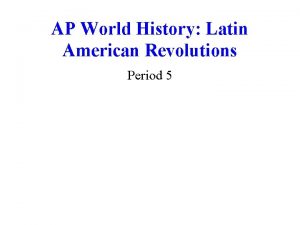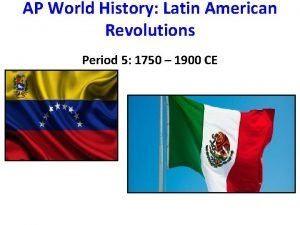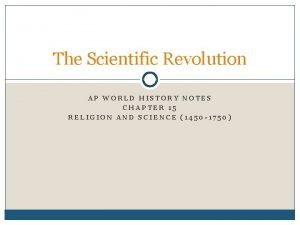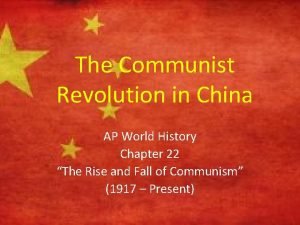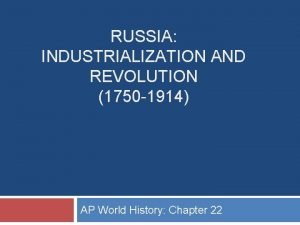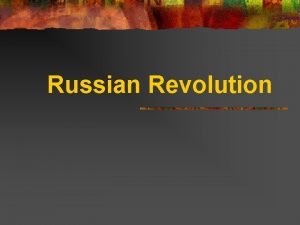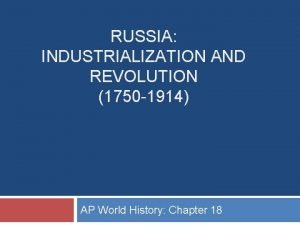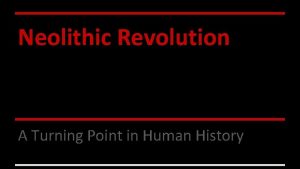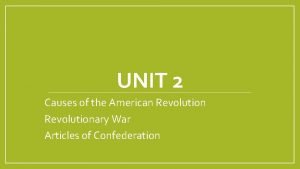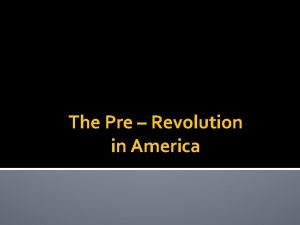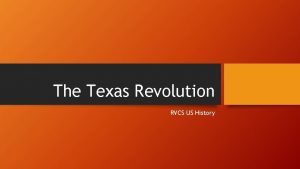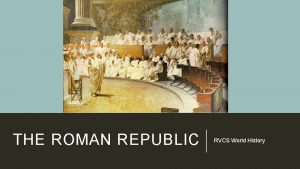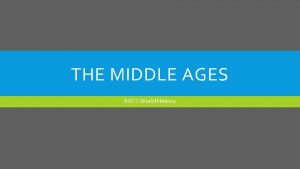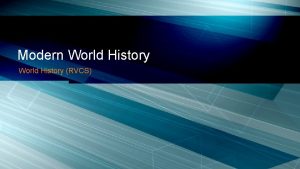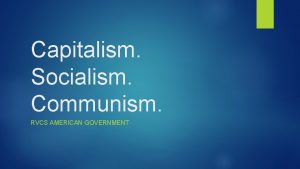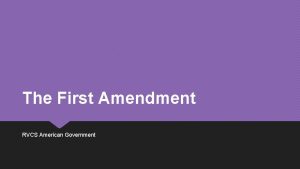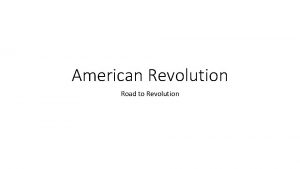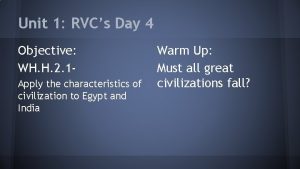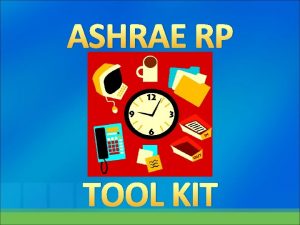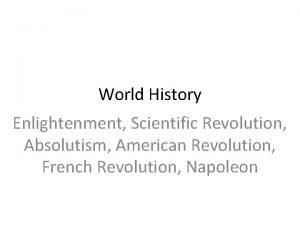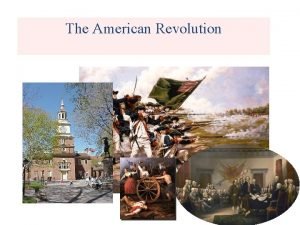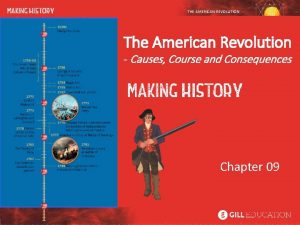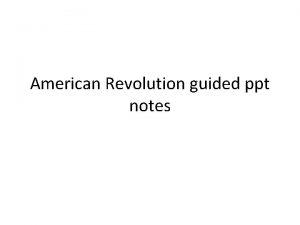THE AMERICAN REVOLUTION RVCS US HISTORY AMERICAN REVOLUTION

![AMERICAN REVOLUTION IN 9 MINUTES • [video] https: //www. youtube. com/watch? v=u 2 xwo. AMERICAN REVOLUTION IN 9 MINUTES • [video] https: //www. youtube. com/watch? v=u 2 xwo.](https://slidetodoc.com/presentation_image_h2/e7677b47d976534f66a69324bbc9233d/image-2.jpg)













![BOSTON MASSACRE VIDEOS • [video 1] https: //www. youtube. com/watch? v=O 05 r. NWyg. BOSTON MASSACRE VIDEOS • [video 1] https: //www. youtube. com/watch? v=O 05 r. NWyg.](https://slidetodoc.com/presentation_image_h2/e7677b47d976534f66a69324bbc9233d/image-16.jpg)


![POSTMASTER, BEN FRANKLIN • [video] http: //www. history. com/topics/american-revolution/benjaminfranklin/videos/postmaster-ben-franklin POSTMASTER, BEN FRANKLIN • [video] http: //www. history. com/topics/american-revolution/benjaminfranklin/videos/postmaster-ben-franklin](https://slidetodoc.com/presentation_image_h2/e7677b47d976534f66a69324bbc9233d/image-19.jpg)



![INTOLERABLE ACTS VIDEO • [Video] https: //www. youtube. com/watch? v=vt_3 adgu. YSM • 0: INTOLERABLE ACTS VIDEO • [Video] https: //www. youtube. com/watch? v=vt_3 adgu. YSM • 0:](https://slidetodoc.com/presentation_image_h2/e7677b47d976534f66a69324bbc9233d/image-23.jpg)



![THE WARNING CALL • [video] https: //www. youtube. com/watch? v=ux_b. JJN 9 Gd 4#t=28 THE WARNING CALL • [video] https: //www. youtube. com/watch? v=ux_b. JJN 9 Gd 4#t=28](https://slidetodoc.com/presentation_image_h2/e7677b47d976534f66a69324bbc9233d/image-27.jpg)

![LEXINGTON & CONCORD VIDEO • [video] https: //www. youtube. com/watch? v=a_KOu 09 z_GA LEXINGTON & CONCORD VIDEO • [video] https: //www. youtube. com/watch? v=a_KOu 09 z_GA](https://slidetodoc.com/presentation_image_h2/e7677b47d976534f66a69324bbc9233d/image-29.jpg)




![THE MUPPETS REENACT THE 2 ND CONTINENTAL CONGRESS • [video] https: //www. youtube. com/watch? THE MUPPETS REENACT THE 2 ND CONTINENTAL CONGRESS • [video] https: //www. youtube. com/watch?](https://slidetodoc.com/presentation_image_h2/e7677b47d976534f66a69324bbc9233d/image-34.jpg)







![LIST 25 VIDEO ON AM. REV. • [video] https: //www. youtube. com/watch? v=H 8 LIST 25 VIDEO ON AM. REV. • [video] https: //www. youtube. com/watch? v=H 8](https://slidetodoc.com/presentation_image_h2/e7677b47d976534f66a69324bbc9233d/image-42.jpg)



![TRENTON VIDEO • [video] http: //www. history. com/topics/american-revolutionhistory/videos/george-washington-makes-surprise-attack-on-trenton# TRENTON VIDEO • [video] http: //www. history. com/topics/american-revolutionhistory/videos/george-washington-makes-surprise-attack-on-trenton#](https://slidetodoc.com/presentation_image_h2/e7677b47d976534f66a69324bbc9233d/image-46.jpg)



![SUMTER VIDEO • [video] https: //www. youtube. com/watch? v=Kz. Edt. Ks. Qc. To SUMTER VIDEO • [video] https: //www. youtube. com/watch? v=Kz. Edt. Ks. Qc. To](https://slidetodoc.com/presentation_image_h2/e7677b47d976534f66a69324bbc9233d/image-50.jpg)





- Slides: 55

THE AMERICAN REVOLUTION RVCS US HISTORY
![AMERICAN REVOLUTION IN 9 MINUTES video https www youtube comwatch vu 2 xwo AMERICAN REVOLUTION IN 9 MINUTES • [video] https: //www. youtube. com/watch? v=u 2 xwo.](https://slidetodoc.com/presentation_image_h2/e7677b47d976534f66a69324bbc9233d/image-2.jpg)
AMERICAN REVOLUTION IN 9 MINUTES • [video] https: //www. youtube. com/watch? v=u 2 xwo. Fhk. VTo

MOVEMENTS TOWARD REVOLUTION PART 1

WHAT IS A REVOLUTION? • Scientific Revolution—The heliocentric theory (that the sun is the center of our solar system), as proposed by Nicolaus Copernicus, helped scientists accurately understand the universe. • Application to History—The word “revolution” was still popular during the 1770 s, and it meant “getting back to the correct starting point. ” In other words, “reversing wrongs. ” It did not necessarily mean “rebellion. ” • American History: A series of repeated revolutions? (American Revolution, Civil War, the Temperance Movement, the Civil Rights Movement, etc. )

KING GEORGE III & LORD GRENVILLE • King George III—He became king of England in 1760, and remained on the throne throughout the American Revolution. • [video] https: //www. youtube. com/watch? v=dz 88 z. RWh 9 GI • Lord Grenville—In 1763, Lord (George) Grenville became prime minister of England determined to help George III have control over the colonies.

UNDER THE STRAINS OF THE FRENCH & INDIAN WAR…(REVIEW) • Fighting the F&I War—The American colonists were confident that they could defeat the French with their own soldiers. However, the British sent added troops to ensure their victory. (England 1, Colonists 0) • Financing the F&I War—Having sent the British soldiers to fight, England owed these men their pensions. They could not afford to do so on their own; therefore, they had to draw out more money from the colonists. (England 2, Colonists 0) • Aftermath of the F&I War—The method for drawing money from the colonists would be on common products like sugar, stamps, glass, etc. (England 3, Colonists 0) • Broken Promises of the F&I War—Don’t forget about the Proclamation Line of 1763, which legally did not allow colonists to settle west of the Appalachian Mountains, even though many were promised these land as payment for fighting in the war. (England 4, Colonists 0)

SUGAR VIDEO • https: //www. youtube. com/watch? v=EFlnl. Gx 0 B 5 U • WHY IS THERE A VIDEO ON SUGAR? ? ? • [Interview] What did you eat today?

4 MAJOR ACTS (PUT INTO PLACE BY LORD GRENVILLE) • The Sugar Act of 1764—This act cut in half the tax on raw sugar imported to the colonies, but raised the tax on refined sugar to balance the loss. (in other words, sugar was only expensive for colonists) • The Currency Act of 1764—This act made it illegal for colonial governments to issue any more paper money and denies colonists the right to pay debts to English merchants with colonial currency. (in other words, England was trying to strengthen its own currency at the expense of the colonists) • The Stamp Act of 1765—This act forced colonists to buy stamps to place on legal documents (examples: wills, bills of sale, licenses, pamphlets, and even newspapers). These stamps had to be purchased from government agents. • The Quartering Act of 1765—This act required colonists, when necessary, to house British soldiers. (colonists even had to pay for the soldiers’ firewood and food)

VIDEO ON THE “ACTS” • http: //www. history. com/topics/american-revolutionhistory/videos/colonists-protest-british-policies

THE STAMP ACT (CONTROVERSY) • Importance—While other acts up to this point were annoying to colonists, the Stamp Act, by far, provoked the most controversy. • “No taxation without representation”—This saying declared that England could not tax at will, but needed to have representatives from America to enforce matters of taxation. • Stamp Act Congress—Nine colonies sent representatives to New York City to discuss the Stamp Act controversy. • James Otis—He was the only delegate to the Stamp Act Congress who was not characterized by the governor as a supporter of the imperial (British) government. • Declaratory Act—In 1766, England repealed the Stamp Act, but on the same day adopted the Declaratory Act, which “declared” that colonists were subordinate to England. (More than likely, England was simply trying to retain an image of power while attempting to keep American colonists happy)

TOWNSHEND ACTS • Charles Townshend—In 1767, he became responsible for raising funds for the British empire. • Townshend Acts—Townshend proposed multiple new taxes on colonial imports: paper, paints, lead, glass, and tea. • Board of Customs—Townshend also set up this institution to oversee the collection of taxes and allowed for British officials to search American ships and buildings for potentially smuggled goods. • Reaction—Surprisingly, colonists took longer (about 18 months) to react publically to the Townshend Acts compared to the Stamp Act. • [video] https: //www. youtube. com/watch? v=s. Lm. YVRWq 0 DI

SAMUEL ADAMS • Adams’ Background—Samuel, much like his father, had a heart for politics, and was given a comfortable childhood with great education. Adams, however, was not without a fair share of struggles, sometimes holding very low-paying jobs. • Personal Issues with England—What spurred on hatred towards England was how the government seized and sold his father’s estate to settle land bank accounts. To reply, Adams wrote a series of essays that shocked his fellow Bostonians about how England had violated the Adams’ family’s liberty. • [video, in reference to the Dartmouth] https: //www. youtube. com/watch? v=Sojnd. UE 1 Np. I

SONS OF LIBERTY • Sons of Liberty—This society, often led by wealthy men, held parades and protests, destroyed the hated stamps, and forced stamp distributors to resign. • Founder—Samuel Adams • [video] https: //www. youtube. com/watch? v=ht. Vc. Ve. Kwnww

PROPAGANDA ILLUSTRATION • Hunger Games: Mockingjay Part 1 • 34: 00 -39: 11 • 42: 37 -53: 15 • Staged Propaganda vs. Spontaneous Propaganda • The “Danger” of Propaganda • The Outcome of Propaganda: Violent Suppression Spurs on Revolutionary Feelings

THE BOSTON MASSACRE • The Boston Massacre—On March 5, 1770, the Boston Massacre took place, or what John Adams called, “the murder in King Street. ” • What happened—On that bloody Monday, a barber’s apprentice got into an argument with a British officer over an unpaid bill. This commotion attracted the attention of many Bostonians, and soon, other British soldiers arrived on the scene. One of the soldiers was hit by a hurled object, and then the soldiers responded by shooting at the mob. 3 colonists ended up dead. • British Perspective—This whole scene was planned by radical colonists, and the soldiers unknowingly walked into their trap (it is still uncertain who ordered the soldiers to fire) • American Perspective—This was an act of violence against the colonists. The British stripped liberty away from them in a deadly fashion.
![BOSTON MASSACRE VIDEOS video 1 https www youtube comwatch vO 05 r NWyg BOSTON MASSACRE VIDEOS • [video 1] https: //www. youtube. com/watch? v=O 05 r. NWyg.](https://slidetodoc.com/presentation_image_h2/e7677b47d976534f66a69324bbc9233d/image-16.jpg)
BOSTON MASSACRE VIDEOS • [video 1] https: //www. youtube. com/watch? v=O 05 r. NWyg. HF 4 • [video 2] https: //www. youtube. com/watch? v=IDb. JYf. If. Q_8

COMMITTEES OF CORRESPONDENCE • Committees of Correspondence—These voluntary “committees” (groups of colonists) formed all throughout the colonies to have a network of communication about their goals in dealing with England. • Compare to Twitter #’s

#HASHTAG THE AMERICAN REVOLUTION • If you fight for us, we will give you the Ohio Valley. Not! #proclineof 1763 • @gwash 1234 • The gov is killing us with these stamps! #boycott #stampsareforlamps • @jamesotistherebel • Protest tonight! Be there… #sonsofliberty • @samadamssonsoflib • Not even safe in our own streets… #bostonmassacre • @therealjohnadams
![POSTMASTER BEN FRANKLIN video http www history comtopicsamericanrevolutionbenjaminfranklinvideospostmasterbenfranklin POSTMASTER, BEN FRANKLIN • [video] http: //www. history. com/topics/american-revolution/benjaminfranklin/videos/postmaster-ben-franklin](https://slidetodoc.com/presentation_image_h2/e7677b47d976534f66a69324bbc9233d/image-19.jpg)
POSTMASTER, BEN FRANKLIN • [video] http: //www. history. com/topics/american-revolution/benjaminfranklin/videos/postmaster-ben-franklin

BOSTON TEA PARTY (BACKGROUND) • Repeal of Townshend Acts—In 1770, all of the Townshend Acts were repealed except the tax on tea. • East India Company—By 1773, the East India Company (British-owned) was financially ruined. The Tea Act was put into law that allowed the East India Company to ship its tea directly to the colonies at a lower cost (avoidance of duties). At such a low cost, the East India Company could have a “monopoly” in America. • Reaction—Even though Americans could now buy tea at a lower cost, they viewed England’s Tea Act as a way to control them, prohibit their liberty, and benefit their own company.

BOSTON TEA PARTY (THE EVENT) • Boston Tea Party—On the night of December 16, 1773, a group of citizens disguised themselves as Native Americans and secretly boarded the tea-filled ships in the Boston Harbor. They dumped 340 chests of tea into the harbor as an act of resistance to the British. • [video] http: //www. history. com/topics/american-revolution/stampact/videos

INTOLERABLE ACTS • Intolerable Acts—Obviously, the “Intolerable Acts” was a nickname given by the colonists. These series of acts were legalized in 1774 as a reply to the Boston Tea Party. • Boston Port Bill—This act closed the port of Boston until the East India Company was reimbursed for the destroyed tea. • Administration of Justice Act—This act guaranteed British officials that if they were accused of legal offenses against colonists, they would be tried in England. • Massachusetts Government Act—This act attempted to restrict governmental power in Massachusetts and grant broader power to the royal governor (appointed by England) • Quartering Act—This act provided that British troops be housed
![INTOLERABLE ACTS VIDEO Video https www youtube comwatch vvt3 adgu YSM 0 INTOLERABLE ACTS VIDEO • [Video] https: //www. youtube. com/watch? v=vt_3 adgu. YSM • 0:](https://slidetodoc.com/presentation_image_h2/e7677b47d976534f66a69324bbc9233d/image-23.jpg)
INTOLERABLE ACTS VIDEO • [Video] https: //www. youtube. com/watch? v=vt_3 adgu. YSM • 0: 20 -5: 05; 9: 55 -End

THE 1 ST CONTINENTAL CONGRESS • Philadelphia—On September 5, 1774, every colony (except Georgia) sent delegates to Philadelphia, PA to discuss what should be done concerning the crisis with England. • “Declaration and Resolves”—The Congress recorded a declaration and 4 “resolves” (statements of purpose). Independence was not their goal…yet. • Boycott—The Congress also helped organize stricter boycotts of English goods. Soon, trade with England slowed considerably. • [video] https: //www. youtube. com/watch? v=Gck. RP 2 x. RKNw

PATRICK HENRY • Speech—Patrick Henry is most famous for his “Give me liberty, or give me death!” speech. It occurred on March 28, 1775 to the Virginia House of Burgesses: o Gentlemen may cry, Peace but there is no peace. The war is actually begun! The next gale that sweeps from the north will bring to our ears the clash of resounding arms! Our brethren are already in the field! Why stand we here idle? What is it that gentlemen wish? What would they have? Is life so dear, or peace so sweet, as to be purchased at the price of chains and slavery? Forbid it, Almighty God! I know not what course others may take; but as for me, give me liberty or give me death! o [video] https: //www. youtube. com/watch? v=0 i. Hwnd. On-4 A

THE FIGHTING BEGINS PART 2
![THE WARNING CALL video https www youtube comwatch vuxb JJN 9 Gd 4t28 THE WARNING CALL • [video] https: //www. youtube. com/watch? v=ux_b. JJN 9 Gd 4#t=28](https://slidetodoc.com/presentation_image_h2/e7677b47d976534f66a69324bbc9233d/image-27.jpg)
THE WARNING CALL • [video] https: //www. youtube. com/watch? v=ux_b. JJN 9 Gd 4#t=28 • The “Minutemen”—This colonial militia had been training to fight upon a minute’s notice. • Town of Lexington—General Gage of England led 700 troops to march to Lexington for the purpose of arresting patriot leaders, John Hancock and Samuel Adams. • It was not necessarily done to provoke a full-blown war • Paul Revere’s Ride—On the night of April 18, 1775, Paul Revere (along with William Dawes and Samuel Prescott) sounded the legendary warning call, “The British are coming!”

BATTLES OF LEXINGTON & CONCORD • Battle of Lexington—Upon arrival, Major John Pitcairn (England) demanded that Captain John Parker (Colonial) and his men step aside and lay down their weapons. Parker ordered his men to do the first, but not the second. No one knows who it was, but somebody fired a shot, which led to the fight of Lexington, an incredibly short incident lasting less than a minute. But by the end, several of the Lexington locals were killed or injured, with only one injury among the British. o The first shot of the American Revolutionary War—It has been called the “shot heard ‘round the world. ” • Battle of Concord—The British had arrived in the town with no opposition at first. Colonel Barrett (Colonial), then, ordered the men to load their weapons and march toward the North Bridge—he had seen smoke and assumed the British were torching the village (it was actually wood-burning). In a shock to the British Empire, the unsuspecting soldiers lost this battle, and fled back towards Boston.
![LEXINGTON CONCORD VIDEO video https www youtube comwatch vaKOu 09 zGA LEXINGTON & CONCORD VIDEO • [video] https: //www. youtube. com/watch? v=a_KOu 09 z_GA](https://slidetodoc.com/presentation_image_h2/e7677b47d976534f66a69324bbc9233d/image-29.jpg)
LEXINGTON & CONCORD VIDEO • [video] https: //www. youtube. com/watch? v=a_KOu 09 z_GA

FORT TICONDEROGA & THE GREEN MOUNTAIN BOYS • Ethan Allen—Having heard the news of British soldiers in Lexington, Ethan Allen formed a frontier militia known as the “Green Mountain Boys. ” • Fort Ticonderoga—The Green Mountain Boys had their eyes set on capturing the British stronghold, Fort Ticonderoga. They succeeded in their surprise attack. A few days later, they captured Crown Point, another fort just north of Fort Ticonderoga. • [song] https: //www. youtube. com/watch? v=Y 4 Kc. JTP 8 n. W 8

BATTLE OF BUNKER HILL • The Battle—This was the first major battle of the war. Fought in Charlestown, across the river from Boston, General William Howe led the British troops. Although he could have taken Bunker Hill almost bloodlessly, he recklessly marched his men up what was called “Breed’s Hill, ” though we remember it as the Battle of “Bunker Hill. ” In all, Howe lost about 40% of his men, including all 12 of his staff officers. This remarkable victory gave the colonists a sense of pride and confidence that they were able to defend themselves against the British army. • Boston—The Patriots secured the city of Boston, pushing General Howe of Britain to retreat to Canada. • [see picture on next slide]


SECOND CONTINENTAL CONGRESS • Congress—They met in late spring of 1775. John Hancock was elected president, but even at this time, the thought of separating from England was not strong. • George Washington—Congress appointed George Washington as commander-in-chief over the continental army. He was chosen over the native Massachusetts candidate, Artemus Ward. Some wondered if selecting a southerner (Washington) would be wise. • [video] https: //www. youtube. com/watch? v=Xwx. Nbl 2 Hek. Q
![THE MUPPETS REENACT THE 2 ND CONTINENTAL CONGRESS video https www youtube comwatch THE MUPPETS REENACT THE 2 ND CONTINENTAL CONGRESS • [video] https: //www. youtube. com/watch?](https://slidetodoc.com/presentation_image_h2/e7677b47d976534f66a69324bbc9233d/image-34.jpg)
THE MUPPETS REENACT THE 2 ND CONTINENTAL CONGRESS • [video] https: //www. youtube. com/watch? v=a. AVpj_Vo 7 zk

INDEPENDENCE! PART 3

A PARABLE FROM “PAPERMAN” • See DVD

COMPARISON PAPERMAN VIDEO AMERICAN REVOLUTION • Man is unhappy with those in authority (his job) • America is unhappy with those in authority (England) • Man becomes infatuated with the woman he meets • America becomes infatuated with the idea of independence • Man takes significant risk by leaving his job • Man gets what he wants (the woman) • Man has to figure out what to do now… • America takes significant risk by leaving England • America gets what it wants (freedom) • America has to figure out what to do now…

THOMAS PAINE • Paine—He was an Englishman that had been living in America since 1774. • Common Sense—This famous pamphlet was published by Thomas Paine in 1776. 120, 000 copies were sold in three months. • Independence—One key feature of this pamphlet included that it was “common sense” for Americans to declare independence from England. • “Europe, and not England, is the parent country of America. This new world hath been the asylum for the persecuted lovers of civil and religious liberty from every part of Europe. Hither they have fled, not from the tender embraces of the mother, but from the cruelty of the monster; and it is so far true of England, that the same tyranny which drove the first emigrants from home, pursues their descendants still. ”

THE DECLARATION OF INDEPENDENCE • Richard Henry Lee—On June 7, 1776, he presented a resolution to the Continental Congress: “Resolved, That these United Colonies are, and of right ought to be, free and independent States…” • Declaration of Independence—On July 4, 1776, Thomas Jefferson’s written statement to declare independence from England was accepted (after much debate and revision) and sent off to be printed. • Thomas Jefferson & John Adams—Jefferson, at this particular time, was a relatively unknown politician. Later, John Adams recorded that he regretted not volunteering to write up the Declaration of Independence. • Slavery & the Declaration—Jefferson’s original draft presented a criticism of England for the slave trade and the legalization of slavery. It was taken out to please South Carolina and Georgia congressmen. • [link] http: //www. loc. gov/exhibits/declara/ruffdrft. html

“BET YOU DIDN’T KNOW” VIDEO • http: //www. history. com/topics/american-revolution/samueladams/videos/founding-fathers-ofinnovation? m=528 e 394 da 93 ae&s=undefined&f=1&free=false

PATRIOTS & LOYALISTS • Adams’ Estimate in 1776: • 1/3 of Americans supported the Patriots (pro-independence) • 1/3 of Americans were Loyalists (against-independence) • 1/3 of Americans were undecided
![LIST 25 VIDEO ON AM REV video https www youtube comwatch vH 8 LIST 25 VIDEO ON AM. REV. • [video] https: //www. youtube. com/watch? v=H 8](https://slidetodoc.com/presentation_image_h2/e7677b47d976534f66a69324bbc9233d/image-42.jpg)
LIST 25 VIDEO ON AM. REV. • [video] https: //www. youtube. com/watch? v=H 8 P 4 up. Xns. CM

COLONISTS’ ADVANTAGES • Personal Motivation—This was their land that they were protecting, unlike British troops who were invading. • “Home Field Advantage”—They had much better knowledge of the geography. • Experienced Military Leaders—Some American fighters, like George Washington, had military experience from the French & Indian War. • British Problems—Some British soldiers were fighting relatives in the colonies. Thus, their motivation was quite limited. • Foreign Aid—America received aid from British enemies: Spain, Holland, and especially France.

COLONISTS’ DISADVANTAGES • Lack of Unity—Throughout the war, the colonists had trouble staying unified, and they even experienced mutiny at times due to financial strains and little food. • Financial Difficulties—Wars can be expensive, especially for a brand new nation. The newly established government had to rely on loans to make the war possible. • Untrained Army—American soldiers were often untrained and poorly disciplined.

THE NEW YORK CAMPAIGN • Battle of Long Island—In the first morning of fighting on Long Island, the British nearly succeeded in surrounding the Continentals. Attempting to flee, they became trapped between the British and the East River. Washington was fortunate, however, as he and his men escaped while Howe paused before delivering the knockout punch and the weather caused limited visibility. Had the British moved quicker, the American army would have been doomed. • [video] https: //www. youtube. com/watch? v=fepgt. Xj. Fo 7 Q • Battle of Trenton—Ultimately, Washington got his men across the Delaware River to Trenton. In spite of sharp criticism over his abilities, Washington led an incredibly successful surprise attack against the “Hessian” troops at Trenton on Christmas night. This was a great risk, for had they not succeeded, fleeing would bring them back to the Delaware River. Washington’s battle plan worked almost exactly as envisioned. .
![TRENTON VIDEO video http www history comtopicsamericanrevolutionhistoryvideosgeorgewashingtonmakessurpriseattackontrenton TRENTON VIDEO • [video] http: //www. history. com/topics/american-revolutionhistory/videos/george-washington-makes-surprise-attack-on-trenton#](https://slidetodoc.com/presentation_image_h2/e7677b47d976534f66a69324bbc9233d/image-46.jpg)
TRENTON VIDEO • [video] http: //www. history. com/topics/american-revolutionhistory/videos/george-washington-makes-surprise-attack-on-trenton#

THE NEW YORK CAMPAIGN (CONTINUED) • Battle of Princeton—Washington’s men tricked the British by leaving their campfires aflame through the night of January 2 -3 to ambush the British once they “took the bait. ” • [video] https: //www. youtube. com/watch? v=RGec. Dmn 6 sh 4 • Battle of Saratoga—In this turning point of the war, General Horatio Gates outfought the British troops who were exhausted and suffered from confused leadership (General Howe and Burgoyne). General Burgoyne of England surrendered nearly 6, 000 men. • [video] http: //www. history. com/topics/american-revolution/americanrevolution-history/videos/battle-of-saratoga-turns-the-tide-of-theamerican-revolution

VALLEY FORGE • Battle of Brandywine—Washington attempted to hold off General Howe’s troops at this battle, but failed to do so. Consequently, Philadelphia was captured on September 26, 1777. Washington retreated to Valley Forge, PA after the failure at Brandywine and a second unsuccessful attempt to ward off Howe at Germantown, PA. • Valley Forge—Washington’s troops rested here for much of the winter of 17771778. However, it was also a difficult time, considering that Philadelphia was lost and that many of his troops had inadequate food and clothing. • [video] http: //www. history. com/topics/us-presidents/georgewashington/videos/george-washingtons-life-changing-battle • France—When hope was fleeting, Washington received wonderful news in May of 1778 that the French navy had agreed to assist the colonies in their fight for independence.

NEW STRATEGIES • Sir Henry Clinton—He replaced General Howe (England) as commander in chief. Clinton’s strategy was to concentrate all northern British forces in one location, leaving Philadelphia to take over New York. • The South—After Clinton’s northern strategy saw little progress, yet another new plan was put into action: invade the South, and then push northward. The British, under General Cornwallis took key cities, such as Savannah (GA), Charleston (SC), and most significantly, Camden (SC), where about 5, 000 Americans were taken as prisoners. • Francis Marion & General Thomas Sumter—Marion and Sumter were two influential Southerners that disrupted the British advances in the South. Marion was known as the “Swamp Fox, ” while Sumter earned the nickname as the “Fighting Game Cock. ”
![SUMTER VIDEO video https www youtube comwatch vKz Edt Ks Qc To SUMTER VIDEO • [video] https: //www. youtube. com/watch? v=Kz. Edt. Ks. Qc. To](https://slidetodoc.com/presentation_image_h2/e7677b47d976534f66a69324bbc9233d/image-50.jpg)
SUMTER VIDEO • [video] https: //www. youtube. com/watch? v=Kz. Edt. Ks. Qc. To

BATTLE OF YORKTOWN • Yorktown—General Cornwallis and his men settled at Yorktown, VA, which is just off the coast of the Chesapeake Bay. Washington made a surprise attack on Cornwallis while the British were waiting on reinforcements. At the same time, a French fleet came in from the Atlantic, while French troops supplemented Washington’s army on land, trapping Cornwallis’s men. • Surrender—Cornwallis surrendered at Yorktown, which included an army of 7, 000 men.

THE TREATY OF PARIS • Treaty of Paris—This was signed in September of 1783, which officially ended the war. England recognized the 13 colonies as “free, sovereign, and independent States. ”

WINNERS & LOSERS? • Who “won” the American Revolution? • Who “lost” the American Revolution? • Don’t forget about people such as the Natives and slaves…

CHALLENGES AHEAD • Now that the colonists had secured independence from England, how would their new government take shape? • Divided opinion: • Federalists—Strong central power (people need unity!) • Anti-Federalists—Strong state power (didn’t the colonists just fight a war to have freedom from a strong centralized power? )

DO YOU LIKE ART/DRAWING? • Check out question 41 for extra credit on your test!
 Did american revolution cause french revolution
Did american revolution cause french revolution Monroe doctrine definition ap world history
Monroe doctrine definition ap world history Jose de san martin definition world history
Jose de san martin definition world history Russian revolution vs french revolution
Russian revolution vs french revolution Modern commercial agriculture
Modern commercial agriculture Hình ảnh bộ gõ cơ thể búng tay
Hình ảnh bộ gõ cơ thể búng tay Lp html
Lp html Bổ thể
Bổ thể Tỉ lệ cơ thể trẻ em
Tỉ lệ cơ thể trẻ em Gấu đi như thế nào
Gấu đi như thế nào Chụp tư thế worms-breton
Chụp tư thế worms-breton Chúa yêu trần thế
Chúa yêu trần thế Kể tên các môn thể thao
Kể tên các môn thể thao Thế nào là hệ số cao nhất
Thế nào là hệ số cao nhất Các châu lục và đại dương trên thế giới
Các châu lục và đại dương trên thế giới Công thức tính thế năng
Công thức tính thế năng Trời xanh đây là của chúng ta thể thơ
Trời xanh đây là của chúng ta thể thơ Cách giải mật thư tọa độ
Cách giải mật thư tọa độ 101012 bằng
101012 bằng Phản ứng thế ankan
Phản ứng thế ankan Các châu lục và đại dương trên thế giới
Các châu lục và đại dương trên thế giới Thơ thất ngôn tứ tuyệt đường luật
Thơ thất ngôn tứ tuyệt đường luật Quá trình desamine hóa có thể tạo ra
Quá trình desamine hóa có thể tạo ra Một số thể thơ truyền thống
Một số thể thơ truyền thống Bàn tay mà dây bẩn
Bàn tay mà dây bẩn Vẽ hình chiếu vuông góc của vật thể sau
Vẽ hình chiếu vuông góc của vật thể sau Thế nào là sự mỏi cơ
Thế nào là sự mỏi cơ đặc điểm cơ thể của người tối cổ
đặc điểm cơ thể của người tối cổ Thứ tự các dấu thăng giáng ở hóa biểu
Thứ tự các dấu thăng giáng ở hóa biểu Vẽ hình chiếu đứng bằng cạnh của vật thể
Vẽ hình chiếu đứng bằng cạnh của vật thể Tia chieu sa te
Tia chieu sa te Thẻ vin
Thẻ vin đại từ thay thế
đại từ thay thế điện thế nghỉ
điện thế nghỉ Tư thế ngồi viết
Tư thế ngồi viết Diễn thế sinh thái là
Diễn thế sinh thái là Dot
Dot Số.nguyên tố
Số.nguyên tố Tư thế ngồi viết
Tư thế ngồi viết Lời thề hippocrates
Lời thề hippocrates Thiếu nhi thế giới liên hoan
Thiếu nhi thế giới liên hoan ưu thế lai là gì
ưu thế lai là gì Khi nào hổ con có thể sống độc lập
Khi nào hổ con có thể sống độc lập Khi nào hổ con có thể sống độc lập
Khi nào hổ con có thể sống độc lập Sơ đồ cơ thể người
Sơ đồ cơ thể người Từ ngữ thể hiện lòng nhân hậu
Từ ngữ thể hiện lòng nhân hậu Thế nào là mạng điện lắp đặt kiểu nổi
Thế nào là mạng điện lắp đặt kiểu nổi Scientific revolution ap world history
Scientific revolution ap world history Chinese revolution ap world history
Chinese revolution ap world history Chinese communist party ap world history
Chinese communist party ap world history Industrialization definition ap world history
Industrialization definition ap world history Http://www.history.com/topics/russian-revolution
Http://www.history.com/topics/russian-revolution Russian revolution of 1905 definition ap world history
Russian revolution of 1905 definition ap world history Why was the neolithic revolution a turning point in history
Why was the neolithic revolution a turning point in history Causes of the american revolutionary war
Causes of the american revolutionary war May 1775
May 1775

